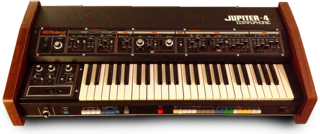
An analog synthesizer is a synthesizer that uses analog circuits and analog signals to generate sound electronically.

Modular synthesizers are synthesizers composed of separate modules for different functions. The modules can be connected together by the user to create a patch. The outputs from the modules may include audio signals, analog control voltages, or digital signals for logic or timing conditions. Typical modules are voltage-controlled oscillators, voltage-controlled filters, voltage-controlled amplifiers and envelope generators.

CV/gate is an analog method of controlling synthesizers, drum machines, and similar equipment with external sequencers. The control voltage typically controls pitch and the gate signal controls note on-off.
The Yamaha AN1x is a DSP-based analog modeling synthesizer, produced by Yamaha Corporation from 1997 to 1998, and was marketed as an "analog physical modelling control synthesizer".

The ARP Odyssey is an analog synthesizer introduced by ARP Instruments in 1972.

The Realistic Concertmate MG-1 is an analog synthesizer manufactured by Moog Music in 1981 and sold by Radio Shack from 1982 to 1983 under their "Realistic" brand name. It was produced without some standard Moog features, such as pitch and modulation wheels, as a cost-cutting measure aimed at achieving a lower price for the consumer market. The synthesizer also featured a pair of pass-through RCA jacks, which allowed users to mix radio or records into the final live synthesized sound output.

The Roland Jupiter-4 (JP-4) was an analog synthesizer manufactured by the Roland Corporation between 1978 and 1981. It was notable as the company's first self-contained polyphonic synthesizer, and for employing digital control of analog circuits, allowing for such features as programmable memory, voice assignment modes, an arpeggiator, polyphonic portamento and others.

The Korg MS-20 is a patchable semi-modular monophonic analog synthesizer which Korg released in 1978 and which was in production until 1983. It was part of Korg's MS series of instruments, which also included the single oscillator MS-10, the keyboardless MS-50 module, the SQ-10 sequencer, and the VC-10 Vocoder. Additional devices included the MS-01 Foot Controller, MS-02 Interface, MS-03 Signal Processor, and MS-04 Modulation Pedal.

MOTM is the name of the modular synthesizer system manufactured by Synthesis Technology. MOTM is an acronym for "Module of the Month".

The Moog Sonic Six is a duophonic analog synthesizer that was manufactured by Moog Music from 1972 to 1979. Because of its portable design and built-in speaker, the Sonic Six was widely used for lectures and educational purposes, often by Bob Moog himself.
The Korg Poly-61(PS-61) is an analog synthesizer manufactured by Korg between 1982 and 1986. It was the first affordable synthesizer to feature two oscillators per voice, and was Korg's first synthesizer to feature digitally-controlled analog oscillators (DCOs). The Poly-61 marked a significant departure in design philosophy from previous Korg synthesizers by replacing the traditional array of dedicated control knobs on the front panel with a digital interface that required users to select parameters individually for adjustment.

The Doepfer A-100 is an analog modular synthesizer system introduced by German audio manufacturer Doepfer in 1995. Although there were only 10 module types at time of release, it currently has more than 120 modules plus several different enclosures and accessories.

Korg MS-10 is an analogue synthesizer created by Korg in 1978. Unlike its bigger brother, the Korg MS-20, the MS-10 only has one VCO, one VCF and one envelope generator. It is monophonic and has 32 keys.
The Roland GR-500 is a guitar synthesizer. Manufactured by the Roland Corporation and FujiGen in 1977, it was one of the first guitar synthesizers.

The Oberheim Xpander is an analog synthesizer launched by Oberheim in 1984 and discontinued in 1988. It is essentially a keyboardless, six-voice version of the Matrix-12. Utilizing Oberheim's Matrix Modulation technology, the Xpander combined analog audio generation with the flexibility of digital controls logic.

The Prophet '08 is a polyphonic analog synthesizer released by Dave Smith Instruments (DSI) in 2007. As with DSI's other instruments, the Prophet '08 uses analog subtractive synthesis. Similar in functionality to the renowned Sequential Circuits Prophet-5 popularized in the 1970s, the Prophet '08 has an all analog signal path; however its envelopes are generated digitally.

The Korg PS-3300 is a polyphonic analog synthesizer released by Korg in 1977. It was released alongside the PS-3100, a more compact variant featuring a complete synthesizer voice board for each of its 48 keyboard notes. The PS-3300 essentially combines three PS-3100 units, triggering all voices simultaneously with each key press and mirroring the PS-3100's overall design, featuring a total of 144 synth voices. The PS-3300 uses the PS-3010, a detachable keyboard equipped with an assignable joystick called the X-Y Manipulator.

The Steiner-Parker Synthacon is a monophonic analog synthesizer that was built between 1975 and 1979 by Steiner-Parker, a Salt Lake City-based synthesizer manufacturer. It was introduced as a competitor to other analog synthesizers, like the Minimoog and ARP Odyssey.

The AX60 is a polyphonic analogue keyboard synthesizer manufactured by Akai Professional in the mid-1980s. It was Akai's answer to the popular Roland Juno series synthesizers. The AX60 uses voltage-controlled analogue oscillators and filter circuitry based on the Curtis Electronics CEM 3394 integrated circuit.

The Roland System 700 was a professional monophonic modular synthesizer for electronic music manufactured by the Roland Corporation and released in 1976 and was followed by the Roland System-100M in 1978.

















